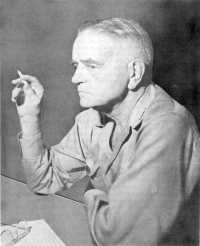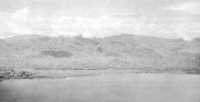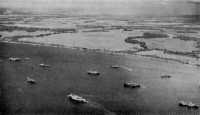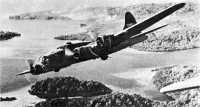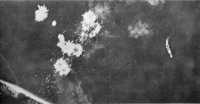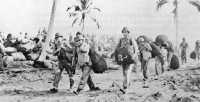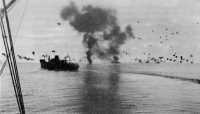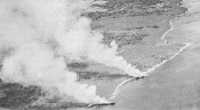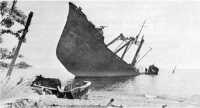Chapter 7: Decision At Sea
On 18 October Admiral Ghormley was relieved and the South Pacific Area received a new commander—Admiral William F. Halsey, Jr.1 Admiral Halsey, then fifty-nine years of age, was one of the most experienced officers of the U.S. Navy. Graduated from the U.S. Naval Academy in 1904 as a passed midshipman, Halsey was commissioned as an ensign in 1906. During World War I he commanded destroyers in British waters. He attended the Navy and Army War Colleges in 1933 and 1934, and then successfully completed the naval aviator’s course at Pensacola.
His career thereafter had been chiefly concerned with aircraft and aircraft carriers. From 1935 to 1937 he commanded the carrier Saratoga. After serving for a year as commanding officer at Pensacola, he took command, as a rear admiral, of Carrier Division 2 (Yorktown and Enterprise) in 1938. The next year he led Carrier Division 1 (Saratoga and Lexington), and in 1940, a vice admiral, he led the Aircraft Battle Force of the Pacific Fleet. Halsey had been on the high seas with a carrier task force at the time the Japanese struck Pearl Harbor on 7 December 1941, and his undamaged task force was fortunately available for a series of raids against the Gilbert, Marshall, Wake, and Marcus Islands in the spring of 1942. He also commanded the task force which took Lt. Col. James H. Doolittle’s medium bombers to within striking distance of Tokyo in April 1942. Illness had kept him out of the Battle of Midway. But the aggressive admiral had now returned to active service, and his audacious spirit was to have a dynamic effect upon the South Pacific.
Although he was unable to visit Guadalcanal until 8 November, Admiral Halsey was well aware of the difficulties which faced him. He had at once to decide whether Guadalcanal should be evacuated or held. On 20 October, following the heavy bombardments and the landings of Hyakutake’s troops, General
Admiral William F. Halsey photographed during a shipboard conference
Vandegrift had reported in person to Admiral Halsey aboard the flagship Argonne in Nouméa Harbor. Present at the meeting were Lt. Gen. Thomas H. Holcomb, the Commandant of the Marine Corps, who was on a tour of inspection, General Harmon, Admiral Turner, and Maj. Gen. Alexander M. Patch, who commanded the Americal Division. Vandegrift informed Halsey that he could hold Guadalcanal if he was given stronger support. The Admiral knew that Guadalcanal must be held, and promised the support of all his available forces. One of his first orders sent Kinkaid’s force to the Santa Cruz Islands where it engaged the Japanese on 26 October.2
The South Pacific Area was soon to receive additional means by which the aggressive spirit could be transformed into action. President Roosevelt and the Joint Chiefs of Staff recognized that the situation on Guadalcanal was extremely serious. On 21 October Admiral King, after an urgent request from the South Pacific for more forces, notified Admiral Nimitz that the Joint Chiefs of Staff had approved a much stronger air establishment for the South Pacific, to be based there by 1 January 1943.3 On 24 October President Roosevelt, in a memorandum for the Joint Chiefs of Staff, expressed a desire that the Joint Chiefs send every possible weapon to Guadalcanal and North Africa even if additional shipments meant reducing commitments elsewhere.4 In reply, Admiral King stated that a considerable force would be diverted, including one battleship, six cruisers, two destroyers, and twenty-four submarines, plus torpedo boats, seventy-five fighter aircraft, forty-one dive and fifteen torpedo bombers. Thirty transports had been allocated to the South Pacific for November, and twenty additional 7,000-ton ships would be diverted later.5
In his reply to the President, General Marshall stated that the situation in the South Pacific depended upon the outcome of the battle then in progress for Guadalcanal. The ground forces in the South Pacific were sufficient for security against the Japanese, he felt, and he pointed out that the effectiveness of ground troops depended upon the ability to transport them to and maintain them in the combat areas. Total Army air strength in the South Pacific then consisted of 46 heavy bombers, 27 medium bombers, and 133 fighters; 23 heavy bombers were being flown and 53 fighters shipped from Hawaii to meet the emergency.
MacArthur had been directed to furnish bomber reinforcements and P-38 replacement parts to the South Pacific. General Marshall had taken the only additional measures which, besides the possible diversion of the 25th Division from MacArthur’s area to the South Pacific, were possible-the temporary diversion of three heavy bombardment squadrons from Australia to New Caledonia, and the release of P-40’s and P-39’s from Hawaii and Christmas Island.6
Reinforcements
Air Power
In October the Japanese had come perilously close to destroying American air strength on Guadalcanal. Despite their utmost efforts the airfield remained in American hands and recovered from the heavy blows, although Guadalcanal’s air strength, impaired by operational losses and Japanese bombardment, remained low during the rest of October. Only thirty-four aircraft were fit to fly on 16 October, but were reinforced on that date by the arrival of twenty F4F’s and twelve SBDs.7 By 26 October, after a series of bombing raids and shellings, there were but twenty-nine operational aircraft at Henderson Field- twelve F4F’s, eleven SBDs, three P-400’s, and three P-39’s.8
By the end of November, with the lessening of Japanese attacks against the Lunga area and the increase of Allied strength in the South Pacific, the Guadalcanal air force had increased in size although as late as 10 November the shortage of fuel prevented heavy bombers from using Henderson Field. General MacArthur on 14 November promised to send eight P-38’s to the South Pacific.
By the middle of November a total of 1,748 men in the aviation units were operating at the Lunga airfields- 1,261 of Marine Air Group 14; 294 of Marine Air Group 142; 33 naval pilots; 144 of the 347th (Army) Fighter Group, and 16 of the 37th (Army) Fighter Squadron.9 By 21 November the entire 5th (Army) Heavy Bombardment Group, which like the 11th had participated in the Battle of Midway, had reached the South Pacific to operate from Espiritu Santo.10 P-38’s had reached Guadalcanal to be based there permanently, and
B-17’s were using the field regularly although the fuel shortage still limited operations.11 On 24 November 94 aircraft on Guadalcanal were operational, including 15 P-39’s, 1 P-40, 8 B-17’s, 11 P-38’s, 9 TBF’s, 6 New Zealand Hudsons, 29 F4F’s, and 15 SBDs, and by 30 November additional reinforcements had increased the total to 188 planes of all types.12
Aola Bay
By November plans for building an additional airfield on Guadalcanal were ready to be put into effect. Prior to Admiral Halsey’s assumption of command, the 1st Battalion of the 147th Infantry, a separate regiment, had sailed from Tongatabu with the mission of occupying Ndeni. General Harmon had not changed his conviction that the occupation of Ndeni would be a needless waste of effort. He presented his opinions to Halsey, who, after conferring with his subordinates, accepted Harmon’s views. On 20 October he directed the 147th Infantry to Guadalcanal.13 The Ndeni operation was never carried out.
Halsey decided to send the 147th Infantry to Guadalcanal to cover the construction of an air strip at a point far enough east of the Lunga to give fighter planes at Lunga Point enough time to rise to the attack if the Japanese attacked the eastern field. Aola Bay, lying about thirty-three miles east-southeast of Lunga Point, was selected by Admiral Turner as the landing and airfield site. The Aola Bay landing force, as finally constituted, was under command of Col. W. B. Tuttle and included 1,700 men of the 1st Battalion, 147th Infantry; two companies of the 2nd (Marine) Raider Battalion; a detachment of the 5th Defense Battalion; Provisional Battery K of the 246th Field Artillery Battalion of the Americal Division, which was equipped with British 25-pounders; and 500 naval construction troops.14
While the practicality of taking Ndeni was being considered, Halsey’s headquarters had completed plans for moving strong reinforcements to Lunga Point. On 29 October Admiral Turner informed General Vandegrift that his requests for more ammunition, materiel, and support were being seriously considered. The admiral planned to have two ships land stores, ammunition, and two batteries of 155-mm. guns on 2 November. Provision for the movement of the 8th Marines of the 2nd Marine Division to Guadalcanal was being given the
highest priority, and that regiment was to land on 3 November. Turner expressed the desire, somewhat gratuitously, that Vandegrift take the offensive after the arrival of the 8th Marines. Another Army regiment and the 1st (Marine) Aviation Engineer Battalion, Turner announced, were to arrive about 10 November, and the 2nd Raider Battalion might possibly land at Beaufort Bay on the south coast about the same time.15 A task force commanded by Rear Adm. Daniel J. Callaghan was constituted to transport the 8th Marines and the Aola Force to Guadalcanal.
The Aola Force, carried on three transports and two destroyer-transports, landed unopposed at Aola Bay on 4 November. It established a 600-yard-long beachhead a short distance east of the Aola River. When the beachhead had been established, command of Colonel Tuttle’s landing force passed from Admiral Callaghan to General Vandegrift. The transports unloaded continuously until 0200, 6 November, and then withdrew. Admiral Halsey directed the raider companies to remain at Aola Bay, instead of leaving with the transports as originally planned.16
The troops established a perimeter defense, and on 29 November four transports landed the 3rd Battalion of the 147th Infantry, additional elements of the 246th Field Artillery Battalion, part of the 9th (Marine) Defense Battalion, and more Seabees.
The Seabees had begun work on an airfield immediately after the landing on 4 November, but the entire area proved to be unsatisfactory. The earth was swampy, and tree stumps with deep, tangled roots slowed the process of clearing the ground. On 22 November Vandegrift, who from the first had opposed the selection of Aola Bay, recommended to Turner that the area be abandoned.17 Admiral Fitch, the commander of South Pacific land-based aircraft, also disapproved of the Aola Bay site; Halsey assented to its abandonment, and the Aola Force, less the 2nd Raider Battalion, was later removed to Volinavua at Koli Point to build an airfield on a grassy plain.18 The movement to Koli Point was completed by 3 December,19 and there the force was joined by the 18th Naval Construction Battalion and the rest of the 9th Defense Battalion.
The site for another airfield was first planned to be at Aola Bay, but terrain conditions forced a move westward to the flat plain at Koli Point
The completed air base at Koli Point can be seen at left, with numerous U.S. navy craft lying offshore. Picture taken some time after the battle
Reinforcement of the Lunga Garrison, 2–4 November
While the initial landings at Aola Bay were being effected on 4 November, more American troops and weapons were strengthening Lunga Point. The Alchiba and the Fuller landed stores and ammunition, together with one Army and one Marine Corps 155-mm. gun battery at Lunga Point on 2 November. These batteries- F Battery of the 244th Coast Artillery Battalion, and another battery of the 5th Defense Battalion-brought in the heaviest American artillery which had been sent to Guadalcanal up to that time, the first suitable for effective counterbattery fire.20
After the landing of a Japanese force east of Koh Point on the night of 2–3 November, Vandegrift asked Halsey to hurry the arrival of the 8th Marines. Callaghan’s task force, which had been delayed by the proximity of enemy forces, sailed into Sealark Channel on 4 November to debark the reinforced 8th Marines, including the 75-mm. pack howitzers of the 1st Battalion, l0th Marines, and the Aola Force as shown above. The regular noon Japanese air attack forced the transports to disperse, and the Lunga Point section of Callaghan’s task force withdrew to the southeast for the night. It returned the next morning to complete the unloading before sailing for Nouméa.21
The Naval Battle of Guadalcanal
Japanese Plans
Following their defeat in the night battles of 23–26 October, the Japanese began preparing for a second major counteroffensive. Staff representatives from the Combined Fleet hurried to Guadalcanal by destroyer to help complete the plans. On 26 October General Hyakutake decided to send the 38th Division, commanded by Lt. Gen. Tadayoshi Sano, and its heavy equipment from Rabaul to Guadalcanal on transports instead of aboard the Tokyo Express. Admiral Isoroku Yamamoto, commanding the Combined Fleet, approved of these plans.22
The Japanese organized four naval task forces for the November operation. Two bombardment forces were to neutralize Henderson Field; a third was to
Strategic air actions during October were carried out against Japanese positions on Gizo Island, where one of a flight of B-17’s is seen leaving the target after the bombing
Action against enemy shipping lying off Buin, Bougainville Island. A salvo of bombs has bracketed a small Japanese freighter as another ship (right) maneuvers to escape the attack. Light areas near top right evidence of an earlier, less successful strike. White spots are enemy machine gun tracers
transport the 38th Division and heavy equipment from Rabaul to Guadalcanal, while a fourth force from the Combined Fleet gave general support.
The 17th Army had first decided to land the 38th Division at Koli Point, whereupon the entire 17th Army was to attack the Lunga area from the east and west. But Imperial General Headquarters, disapproving of the dispersion of forces, directed that the 38th Division deliver its attack from the Matanikau area, where it could receive the maximum support from 17th Army artillery. The 17th Army, however, did land a small force at Koli Point in early November to deliver supplies to some of Shoji’s troops who had retreated there after the October disaster. Orders directing these forces to build an airfield on the flat plain south of Koli Point were also issued.23 A part of the 230th Infantry of the 38th Division had already landed on Guadalcanal in October and on 2–3 November, and the Tokyo Express landed elements of the 228th Infantry along the beaches from Kokumbona to Cape Esperance between 28 October and 8 November.24
Japanese naval units assembled in the harbors between Buin and Rabaul during the first days of November. By 12 November Allied reconnaissance planes reported that two aircraft carriers, four battleships, five heavy cruisers, and thirty destroyers, besides transports and cargo ships, had been assembled. There were sixty vessels in the Buin–Faisi–Tonolei anchorages alone.25 But there was to be one vital difference between the October and November counteroffensives. The Japanese, who had previously been using their aircraft carriers with some success, did not commit them to action in November.
American Plans
American naval forces, though still inferior in number to those of the Japanese, were again to prove their effectiveness. Twenty-four submarines had been patrolling the Tokyo Express routes, and had destroyed or damaged a number of Japanese ships. Besides the submarines, the naval forces under Halsey’s command included the aircraft carrier Enterprise, two battleships, three heavy cruisers, one light cruiser, one light antiaircraft cruiser, twenty-two destroyers, and seven transports and cargo ships, organized into two task forces. Because the lack of gasoline at Henderson Field was limiting the operations of
B-17’s, Admiral Halsey requested the Southwest Pacific Air Forces to bomb shipping around Buin, Tonolei, and Faisi between 11 and 14 November, as well as to reconnoiter the approaches to Guadalcanal.26 Beginning on 10 November, South Pacific land-based aircraft, including those at Henderson Field, were to cover the northern and western approaches and to protect the Lunga area. The plans for the land-based aircraft of the South Pacific did not assign to them new missions, but restated their continuing missions in specific terms.
On Guadalcanal the situation was more hopeful than it had been in October. Pistol Pete could no longer shell the airfields with impunity. The arrival on 2 November of the 155-mm. guns of F Battery, 244th Coast Artillery Battalion, and the battery of the 5th Defense Battalion had provided effective counterbattery artillery.27 Less than four hours after it had begun debarkation at Lunga Point, F Battery of the 244th was in action against Pistol Pete.28 Troop strength had increased with the addition of the 8th Marines on 4 November, and still more reinforcements were expected soon.
The addition of more New Zealand troops and of the first elements of the 43rd (U.S.) Division to the South Pacific force had made it possible to relieve the Americal Division of its mission of defending New Caledonia. The complete division was to be committed to Guadalcanal, where one of its regiments, the 164th Infantry, was already engaged.
Reinforcement by the 182nd Infantry
The next Americal Division unit to be shipped to Guadalcanal was the 182nd Regimental Combat Team, less the 3rd Battalion which was still in the New Hebrides. The movement of this unit to Guadalcanal by Turner’s task force was to be a larger operation than the dispatch of the Aola Bay Force and the 8th Marines.
One of the two South Pacific naval task forces, under command of Admiral Turner, was charged with the dual responsibility of defending Guadalcanal and of transporting troops and supplies to the island. Admiral Kinkaid’s carrier task force at Nouméa was available to support Turner’s force. These forces, though limited in numbers, had to stop the Japanese unless the U.S. Navy was to be driven out of the Solomons.29
Turner’s task force was organized into three groups. Three transports, one cruiser, and four destroyers under Admiral Scott constituted one group. Scott’s ships were to carry marines, ammunition, and rations from Espiritu Santo to Guadalcanal. Admiral Callaghan commanded the second group of five cruisers and ten destroyers which were to operate out of Espiritu Santo and cover the movement of the third group from Nouméa to Guadalcanal. Admiral Turner assumed direct command of the third group, consisting of four transports which were to transfer the 182nd Regimental Combat Team (less the 3rd Battalion), Marine replacements, naval personnel, and ammunition from Nouméa to Guadalcanal.
Admiral Kinkaid’s force at Nouméa, consisting of the carrier Enterprise, two battleships, two cruisers, and eight destroyers, was to support Turner’s force. In addition all aircraft in the South Pacific were to cover the movement of Turner’s ships and to strike at any approaching Japanese vessels. Turner expected that a Japanese invasion fleet would soon be approaching Guadalcanal. He planned to land the 182nd Infantry at Lunga Point and move the transports out of danger before the enemy could arrive. The ships under his direct command sailed from Nouméa at 1500, 8 November. The next day Scott’s group left Espiritu Santo; Callaghan’s warships followed on 10 November. Callaghan’s and Turner’s groups rendezvoused off San Cristobal the next morning.
Scott’s group arrived off Guadalcanal at 0530 on 11 November. The Zeilin, Libra, and Betelgeuse began unloading but were interrupted twice during the day by enemy bombers which damaged all three ships. At 1800 the group withdrew to Indispensable Strait. Damage to the Zeilin was found to be serious, and with one destroyer as escort she returned to Espiritu Santo. Scott’s warships, at 2200, joined Callaghan’s group, which had been preceding the advance of Turner’s transports. The Libra and Betelgeuse later joined Turner’s group. The warships, under Callaghan’s command, then swept the waters around Savo Island, and remained in Sealark Channel for the rest of the night of 11–12 November.
The transports anchored off Lunga Point at 0530, 12 November. Covered by the warships, they began discharging troops and cargo. A Japanese shore battery in the vicinity of Kokumbona opened fire on the Betelgeuse and Libra at 0718 but missed; it ceased firing when one cruiser, two destroyers, and counterbattery artillery on shore replied. About twenty-five enemy torpedo bombers attacked in the afternoon, and forced the ships to cease unloading and get under way. The cruiser San Francisco, which was Callaghan’s flagship, and the
Landing of the 182nd Regimental Combat Team, 12 November was carried out smoothly during the morning as troops hauled their equipment ashore
During the afternoon enemy air attacks temporarily interrupted operations. The cruiser San Francisco was hit (under smoke in distance), but the transport shown and others were undamaged
destroyer Buchanan were damaged but the transports were not hit, and all but one bomber were shot down. The transports re-anchored at 1525, having been forced to halt unloading for two hours.
At 1035 on the same morning American planes patrolling north of Malaita sighted a Japanese force, including two battleships, sailing south toward Guadalcanal. A convoy of transports carrying the 38th Division troops, replacements, and naval troops followed farther to the north. By late afternoon Admiral Turner had concluded that 90 percent of the supplies carried by the ships under his direct command could be unloaded that day, but that several more days would be required to unload the Betelgeuse and Libra. To avoid destruction by the enemy battleships, he decided to withdraw all the cargo ships and transports. The warships were to remain to engage the approaching enemy.
The cargo ships and transports, escorted by destroyers, withdrew at 1815, 12 November.30 Callaghan’s and Scott’s warships preceded them to Indispensable Strait, then reversed their course and returned to protect Guadalcanal. The McCawley and the President Jackson had been completely unloaded; 80 percent of the President Adams’ cargo had been landed, 50 percent of the Crescent City’s, 40 percent of the Betelgeuse’s, and 20 percent of the Libra’s. All the troops, numbering about 6,000 men, had debarked.31 The forces which had been landed by Scott’s group consisted of the 1st (Marine) Aviation Engineer Battalion, ground crews of the 1st Marine Air Wing, and marine replacements. Turner’s ships had landed 1,300 marine replacements, 372 naval personnel, L Battery, 11th Marines (155-mm. howitzers), some 164th Infantry casuals, and the 182nd Infantry Regimental Combat Team. The combat team was made up of the 1st and 2nd Battalions, 182nd Infantry; the 245th Field Artillery Battalion (105-mm. howitzers), plus engineer, medical, quartermaster, and ordnance personnel-3,358 men.32
Cruisers Versus Battleships, 12–13 November
The Japanese force which had been sighted consisted of the battleships Hiei and Kirishima, one light cruiser, and fifteen destroyers.33 This force had orders to enter Sealark Channel and neutralize the airfields on Guadalcanal by
bombardment. Once enough aircraft and supplies had been destroyed, and the airfield pitted, Japanese troops could be transported to Guadalcanal in safety.34 The fact that the battleships carried high explosive ammunition for bombarding the airfield instead of armor-piercing shells reduced the margin of superiority of their 14-inch guns in the ensuing battle, for the battleships’ shells did not always penetrate the cruisers’ armor plate. This was fortunate, for to withstand the enemy force Admiral Callaghan had only two 8-inch gun cruisers, one 6-inch gun cruiser, two light antiaircraft cruisers, and eight destroyers.
Callaghan led his light forces toward Savo after dark to engage the battleships. At 0124 on 13 November Helena’s radar located Japanese ships 27,000 yards away, between Savo and Cape Esperance. A warning was immediately transmitted to the flagship San Francisco, but the cruiser’s search radar was inadequate. As a result Admiral Callaghan, like Admiral Scott at Cape Esperance one month earlier, did not know the exact location of either his own or the enemy ships. The American destroyers closed to short range to fire torpedoes. The vans of the opposing forces intermingled, and the American column penetrated the Japanese formation. The Japanese illuminated the American cruisers, then opened fire at 0148. The outnumbered Americans replied, firing to port and starboard. The American column became disorganized as destroyers maneuvered to fire torpedoes, and both cruisers and destroyers swerved off their courses to avoid collisions. The engagement became a melee in which the desperate American ships engaged the enemy individually. In the confusion both sides occasionally fired on their own vessels. As far as they could, the American ships concentrated their fire on the battleship Hiei.
Admiral Scott, aboard the Atlanta, was killed by fire from a cruiser. Later a salvo from the Hiei struck the San Francisco and killed, among others, Admiral Callaghan, and mortally wounded her commanding officer, Capt. Cassin Young. The San Francisco continued to engage the Hiei as long as her main battery would bear. The Hiei fired several salvos, then ceased. The San Francisco, having received fifteen major hits from heavy guns, withdrew. The Atlanta caught fire, and several American destroyers blew up, but about 0300 the Japanese abandoned their attempt to break through the tenacious American force, and retired northward. Two Japanese destroyers had been sunk, and four were damaged.
The gallantry of the light American forces in this desperate action had saved Henderson Field from a battleship bombardment, but the cost was heavy. Of the thirteen American ships, twelve had been either sunk or damaged. The antiaircraft cruisers Atlanta and Juneau, and the destroyers Barton, Cushing, Laffey, and Monssen sank in the channel. The heavy cruisers San Francisco and Portland and the destroyers Aaron Ward, O’Bannon, and Sterrett, which all had suffered serious damage,35 retired with the two other surviving ships toward Espiritu Santo during the morning of 13 November.
The battleship Kirishima had escaped, but at daylight on 13 November American air forces located the battleship Hiei near Savo. Crippled and on fire, she was cruising slowly in circles. The Hiei, the principal American target, had been struck eighty-five times in the battle, and was out of control. Planes from Henderson Field attacked her steadily all day, and on the night of 14 November she was scuttled by her crew.
Bombing the Japanese Transports, 14 November
Meanwhile Admiral Kinkaid had led his carrier task force from Nouméa toward Guadalcanal. At daylight on 14 November search planes from the Enterprise sighted a group of Japanese cruisers near New Georgia. These ships belonged to a second Japanese force which, consisting of three heavy and two light cruisers and four destroyers from the Outer South Seas Supporting Unit of the 8th Fleet, had entered Sealark Channel early on the morning of 14 November. When American motor torpedo boats sortied from Tulagi, the Japanese retired without having inflicted much damage to Henderson Field. Later, when the search planes found this force, aircraft from Guadalcanal and from the carrier attacked it and sank one heavy cruiser and damaged one heavy and one light cruiser and a destroyer. After these attacks the planes from the Enterprise flew to Guadalcanal to operate temporarily from Henderson Field. This permitted the Enterprise, the only remaining carrier in the South Pacific, to withdraw to the south out of range of hostile aircraft.36
Disregarding the fact that the American airfields on Guadalcanal were still in operation, the Japanese determined to bring the troop convoy to Guadalcanal. On 14 November it left the waters near northern New Georgia, where it had been standing by since 13 November, to sail southward down the Slot. Consisting
of eleven transports and cargo ships and twelve escorting destroyers,37 this convoy was the largest the Japanese had yet employed in the Solomons. The ships carried about 10,000 troops of the 229th and 230th Regiments of the 38th Division, artillerymen, engineers, replacement units, a naval force of between 1,000 and 3,500 men, weapons, and 10,000 tons of supplies.38 The Japanese had not committed aircraft carriers to close support of operations, and the convoy’s air cover was weak.
A Southwest Pacific patrol plane, lending support to the South Pacific, discovered the convoy at 0830, 14 November, about 150 miles from Guadalcanal. Guadalcanal aircraft and the Enterprise air group made ready to attack with torpedoes, bombs, and machine guns. Ground crews servicing the planes rolled bombs across the muddy runways, lifted them into the bays, and fuelled the planes entirely by hand. The planes took off and struck the transports continuously throughout the day with outstanding success. They hit nine transports. Seven sank at sea, and the four remaining afloat sailed on toward Guadalcanal under cover of darkness.
Night Battleship Action, 14–15 November
Strengthened and reorganized, the heavy bombardment force which had fought the American cruisers on the night of 12–13 November turned back toward Guadalcanal to cover the approach of the transports. It consisted of the battleship Kirishima, two heavy and two light cruisers, and nine destroyers. To combat this force and to attack any surviving transports, Admiral Halsey sent the battleships Washington and South Dakota and four destroyers from Kinkaid’s force to the north. Under the command of Rear Adm. Willis A. Lee, Jr., the two battleships and four destroyers passed the southeastern tip of Guadalcanal about noon on 14 November. Shortly before midnight, they entered the channel. As the Washington neared Savo in the darkness at 0001, 15 November, her radar located an enemy ship. The Washington opened fire at 0016, at a range of 18,500 yards, and the South Dakota and the destroyers entered the action immediately thereafter. The Japanese fought back vigorously, but by 0142 the long-range gun fight in the narrow waters had ended. It was one of the few engagements between battleships of the entire war. The Japanese retired northward, having again failed to hit the airfields. The badly damaged Kirishima was
Japanese transports beached and burning 14 November. Three of the four enemy transports which succeeded in reach Guadalcanal. The Kinugawa Maru, seen still burning just east of the Bonegi River mouth at Tassafaronga Point. In the distance near Bunina Point is a third hulk
The third hulk from the above picture, with wrecked Japanese landing barge in the foreground
scuttled by her crew; one Japanese destroyer sank. Three of the American destroyers sank, and the South Dakota and the other destroyer suffered damage.39
When day broke on 15 November the Americans saw, lying at Tassafaronga in plain view, the four surviving transports of the force which had been hit the day before. The transports had no air cover. Three were beached and unloading, while the fourth was slowly pulling northward toward Doma Reef. F Battery of the 244th Coast Artillery Battalion had moved two of its guns from their field artillery positions on the west bank of the Lunga to the beach. These guns opened fire at 0500 and hit one beached transport 19,500 yards away; the ship began to burn.40 The 3rd Defense Battalion’s 5-inch batteries opened fire forty-five minutes later on a second ship 15,800 yards away and hit her repeatedly. The beached target burned and listed to port.41 The destroyer Meade sailed over from Tulagi to shell both the ships and the landing areas,42 while aircraft from Henderson Field and bombers from Espiritu Santo attacked the remaining ships. By noon all four had been turned into burning, useless hulks which were abandoned to rust in the shallow water. The planes then turned their attention to the Japanese supplies which had been landed, and started tremendous fires among the piles of materiel. One blaze was 1,000 yards long.43
Cost and Results
Of the ill-fated convoy’s 10,000 or more troops, about 4,000 had landed safely on Guadalcanal,44 but without sufficient supplies and rations. Only five tons of the 10,000 tons of supplies aboard the ships were landed safely.45 Of the rest of the troops, some had drowned at sea, but a large number were rescued by the Japanese.46
The destruction of the convoy brought the November counteroffensive to a quick end. For the Japanese the failure had been expensive. Besides the troops and supplies lost at sea, they had lost two battleships, one heavy cruiser, and three destroyers sunk. Equally serious had been the destruction of the eleven ships in the convoy, a total loss of 77,609 shipping tons.47 Two heavy cruisers,
one light cruiser, and six destroyers had been damaged. The U.S. Navy had lost one light cruiser, two light antiaircraft cruisers, and seven destroyers sunk, and one battleship, two heavy cruisers, and four destroyers damaged.
This was the last major effort by the Japanese Army and Navy to recapture the Lunga area by a coordinated attack. The November battle had made the task of reinforcing Guadalcanal much less dangerous. The movement of the 182nd Infantry was the last shipment of troops to Guadalcanal in the face of enemy forces. Thereafter American troops were to be landed on Guadalcanal fairly regularly, and although enemy air attacks continued, and the Alchiba was torpedoed by a submarine on 28 November, the danger of attack by enemy warships lessened. The Lunga area was now securely held, for by the end of November Vandegrift’s force totaled 39,416 men.48
The November battle had been the most decisive engagement of the Guadalcanal campaign. It had almost “sealed off” the Japanese on the Guadalcanal battlefields from their rear bases. After November, the most important factor of the campaign was to be the long hard ground fighting on the island itself.
